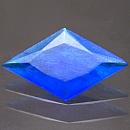|
|
||||||||||||||||
|
||||||||||||||||
|
||||||
|
|
|
|
Chalcanthite
|
|
| | |
| Discovered in 1853; IMA status: Valid (pre-IMA; Grandfathered) | ||
|
| ||
|
Chemistry |
|
|
| |
|
CuSO4 Ě 5H2O | |
|
|
Hydrated Copper Sulfate |
|
Molecular Weight: |
249.69 gm |
|
Composition: |
Copper |
25.45 % |
Cu |
31.86 % |
CuO |
|
|
Hydrogen |
4.04 % |
H |
36.08 % |
H2O |
|
|
Sulfur |
12.84 % |
S |
32.07 % |
SO3 |
|
|
Oxygen |
57.67 % |
O |
|
|
|
|
|
100.00 % |
|
100.00 % |
= TOTAL OXIDE |
|
|
|
||||
|
Classification |
|
|
| |
|
Sulfates | |
|
6/C.04-40 | |
|
|
7 : SULFATES (selenates, tellurates, chromates, molybdates, wolframates)
|
|
Related to: |
Chalcanthite Group. Copper analog of Melanterite. |
|
Members of Group: |
Chalcanthite Group: Chalcanthite, J˘kokuite, Pentahydrite, Siderotil |
|
Varieties: |
Phillipite |
|
Synonyms: |
Blue Stone, Blue Vitriol, Chalkanthite, Copper Vitriol, Cyanosite, Cyprian Vitriol, Suphate of Copper |
|
|
|
|
Crystal Data |
|
|
|
|
|
Crystal short prismatic {001} or less commonly tabular {111}. Natural crystals rather rare. Commonly found as stalactic material, massive, granular filling veins (cross-fiber veinlets) and as crusts. |
|
|
Rarely as cruciform intergrowths with {010} common between individuals. |
|
|
|
|
|
Physical Properties |
|
|
|
|
|
Imperfect on {110}, Indistinct on {111}; and, {110} in traces |
|
|
Conchoidal |
|
|
Brittle |
|
|
2.5 |
|
|
2.286 (g/cm3) |
|
|
None |
|
|
Not Radioactive |
|
|
Other: |
Soluble in water, dehydrates in dry air. |
|
Health Warning: |
CAUTION: Poisonous! Copper sulfate solutions are poisonous. Do not lick or ingest. Do not touch with bare hands or wash hands immediately after handling! |
|
|
|
|
Optical Properties |
|
|
|
|
|
Green, Green Blue, light Blue, or dark Blue; Colorless to pale Blue in transmitted light |
|
|
Translucent to Transparent |
|
|
Vitreous to Resinous |
|
|
1.516 - 1.546 Biaxial ( - ) |
|
|
0.0300 |
|
|
r < v |
|
|
None |
|
|
|
|
|
Occurances |
|
|
|
|
|
Geological Setting: |
A secondary mineral in the oxidized portions of copper sulfide deposits, commonly of post-mining formation, forming on mine walls and by the action of acidic surface waters on copper veins; rarely as a fumarolic deposit. |
|
Common Associations: |
Melanterite, Fibroferrite, Rhomboclase, Epsomite, Goslarite, Pickeringite, Retgersite, Morenosite, Brochantite, Gypsum |
|
Common Impurities: |
Fe, Mg, Co |
|
Type Locality: |
Chuquicamata Mine, Chuquicamata District, Calama, El Loa Province, Antofagasta Region, Chile |
|
Year Discovered: |
1853 |
|
View mineral photos: | |
|
|
|
|
More Information |
|
|
|
|
|
| |
|
|
|
|
Natural gem-quality crystals are quite rare so gems are mostly faceted from lab-grown material. These gems have one of the most intense, saturated bright blue colors availble for gems. Care must be taken to store gems or specimens in a sealed container with a desiccant to keep them dry since Chalcanthite can slowly absorb moisture from the air then lose it again. Over time, this cycle can cause a beautiful gem or mineral specimen to be reduced to a pile of blue dust. Deposits
of Chalcanthite are widespread; commercial deposits
may occur in arid regions. From the Island of Cyprus.
On Vesuvius, Campania, Italy. From Rammelsberg and Goslar,
Harz Mountains, Germany. Abundant at Rio Tinto, Huelva,
Spain. In Chile, from Chuquicamata, at Quetena, near
Calama, and Copaquire, Antofagasta. In the USA, in Arizona,
at the United Verde mine, Yavapai County, and in the
Clifton-Morenci district, Greenlee County; from the
Blue Bird mine, Fierro-Hanover district, Grant County,
New Mexico; commercial amounts in the Bluestone mine,
Yerington district, Lyon County, Nevada; at Butte, Silver
Bow County, Montana; from Ducktown, Polk County, Tennessee.
|
|
|
We
have not photographed our Chalcanthite gems. Please
check back soon. |
